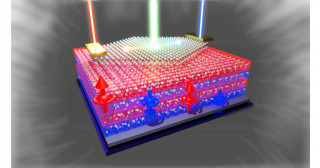In the standard model of thrombopoiesis, thrombopoietin (TPO) initiates a series of events that leads to the differentiation and maturation of megakaryocytes and finally the shedding of platelets into the blood stream. However, quantitative studies suggest that while this model explains the homeostatic levels of platelets in the body, it does not adequately explain how the body rapidly produces the necessary number of platelets in response to acute wounds. New work by Koji Eto and his lab at the Dept of Clinical Applications gives new insight on this question. In collaboration with researchers at the University of Tokyo and Jichi Medical University, the group used two-photon microscopy to directly observe platelet production in the body, finding there exists a previously unknown TPO-independent mechanism that depends on the immune system and activates upon acute trauma.
The mechanism operates using the caspase-3 signaling pathway and is triggered by the cytokine interleukin (IL)-1α. IL-1α is an inflammatory signal and offers a clue as to why acute inflammation is accompanied by an increase in platelet levels. According to Eto, "It remains a mystery why inflammation is associated with platelet numbers." In the TPO-dependent mechanism, megakaryocytes grow in size and extend proplatelets, which penetrate into the blood stream where they are eviscerated into smaller fragments -- platelets -- by the blood flow. In the novel mechanism, IL-1α causes irregular changes in the morphology of the megakaryocyte, which leads to the cell rupturing and releasing platelets much faster than otherwise. The rupturing is attributed to a weaker membrane and results in a 20-fold increase in platelet count within an hour of the mechanism's initiation. IL-1α also promoted megakaryocyte ploidy and maturation, two phenotypes thought to correlate with platelet numbers. Although the platelets generated from this caspase-3 system tended to be larger than those generated by the TPO mechanism, thus showing different phenotypes, they nevertheless demonstrated good function.
The work is the first to show direct evidence that inflammation-related cytokines, and by extension the immune system, regulate thrombopoeisis. Eto is curious about how strong this relationship is. "It will be interesting to see if other interleukins have similar effects."
Paper Information
[DOI] http://dx.doi.org/10.1083/jcb.201410052
[KURENAI Access URL] http://hdl.handle.net/2433/197926
Satoshi Nishimura, Mika Nagasaki, Shinji Kunishima, Akira Sawaguchi, Asuka Sakata, Hiroyasu Sakaguchi, Tsukasa Ohmori, Ichiro Manabe, Joseph E. Italiano Jr., Tomiko Ryu, Naoya Takayama, Issei Komuro, Takashi Kadowaki, Koji Eto, and Ryozo Nagai
"IL-1α induces thrombopoiesis through megakaryocyte rupture in response to acute platelet needs"
Journal of Cell Biology Vol. 209 No. 3 pp. 453–466 Published May 11, 2015
Reference
Nishimura S, Nagasaki M, Kunishima S, et al. (2015) IL-1α induces thrombopoiesis through megakaryocyte rupture in response to acute platelet needs. Journal of Experimental Medicine





